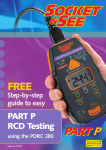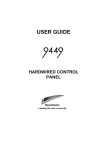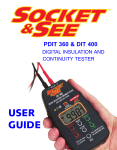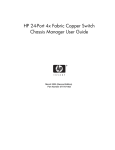Download Socket & See PDL310 Technical Document - Stroma
Transcript
FREE Step-by-step guide to easy PART P Loop Testing using the PDL 310 Issue no. 01/07 Loop testing What IS the Loop and why must it be tested? Setting up the PDL 310 You must first understand that the loop to be tested includes the supply system, so the mains must be switched on to carry out When a fault occurs in an electrical system, the over-current device a test. must open the circuit to cut off current quickly. In domestic circuits this device will be a miniature circuit breaker (MCB) or a fuse, both of which operate when the current they carry exceeds the rated value. The supply voltage drives this fault current, the value of the current depending on this voltage and the resistance (strictly the impedance) of the circuit in which it flows. A higher voltage or lower impedance will result in a greater current and a faster time of operation of the fuse or of the circuit breaker. It is of the greatest importance that the circuit concerned is disconnected as quickly as possible, to prevent dangers due to Caution We strongly advise reading and understanding this guide before the instrument is used. In particular note the safety issues that follow:■ Although fully protected up to 600V AC this tester is for use on 230V AC circuits only. ■ Always check the tester on a known correctly wired live socket outlet before and after use. ■ Before use - check your tester for any damage to the plug, lead and cabinet. electric shock or to fire. The supply voltage is fixed by the Supply Company, so to achieve the greatest possible level of safety we must ensure that the impedance of the path taken by the fault current is low enough to ensure rapid operation of the protective device. This path is called the earth fault loop, or sometimes simply the loop. This loop may be extensive, going through the installation itself and all the way back to the Supply Company’s transformer. The PDL 310 measures the impedance of this loop, and thus checks the safety of Plug the tester into a socket on the circuit to be tested as shown in Figure 1. the system. The lower the loop impedance, the greater the fault current and the more quickly the circuit is disconnected. So what should the value be? Loop impedance values There is no single, simple answer to the question “What is an acceptable value for fault loop impedance?” The answer is, of course, the impedance that will allow enough fault current to operate the fuse or circuit breaker quickly enough to prevent damage to the installation or to those using it. But this impedance depends on the exact operating characteristics of the fuse or the circuit breaker concerned, as well as on the rating of the device. For example, a rewireable fuse requires lower loop impedance than does a cartridge fuse, whilst the acceptable value is higher for a miniature circuit breaker. Again, a 30 A fuse will require a much lower loop impedance value than will a 5 A fuse. Exact maximum values for loop impedance are to be found in tables forming part of the IEE Wiring Regulations (BS 7671). This publication can be difficult to interpret. A little later a simplified explanation of the acceptable results will be given. 1 The PDL 310 connected ready for use Switch the socket on, when the instrument will go through its pre-test routine. The three LEDs in the orange triangle on the tester Reversed Supply Polarity will be a steady green accompanied by a series of bleeps while the instrument sets itself up into its operating condition. If the LEDs are It is seldom appreciated that the supply to an installation can be not all green (indicating faulty wiring or connections), the tester will misconnected so that the live (phase) and neutral/earth supply automatically lock out to prevent further tests. Should any of the conductors are reversed. This state of affairs is extremely rare, but LEDs in the triangle be lit or flashing as red or orange accompanied very dangerous indeed, because the live (phase) of the supply by a warbling tone, this indicates a wiring fault, the nature of which system will in many cases be connected directly to the earthing is shown by the list on the front of the instrument and in more detail system, so that all earthed metal will become live. If this mistake by the table on the back of this Guide. This extremely valuable test has been made there will be no obvious sign, with sockets and all facility is built in to the PDL 310. Such faults may require assistance equipment operating normally and most loop impedance testers and advice to correct them. will not show that a dangerous situation exists. In the event of a socket not being available, the PDL 310 loop tester The supply polarity can be verified by applying firm (thumb) can be powered by connecting it to any suitable supply, possibly at pressure onto the orange area at the bottom of the front panel of a consumers unit, using a fused test lead set. Care must be taken to the tester, which is labelled PRESS AND HOLD. Note that this ensure that the brown lead is connected to the phase (live). Note area does not depress as is the case with the ON/OFF, PFC and this picture shows using the Socket & See ITLS 400 fused test lead LOOP-PFC TEST buttons above it. set, the blue neutral probe can be ‘piggy backed’ into the green orange triangle remain green as shown in Figure 3, polarity is (earth) unit and then a croc clip attached to the front of the green correct and the loop test can proceed. If the three LEDs in the unit. Your tester is now a two wire testing device and measurement can be made between phase-neutral or phase-earth. WARNING: Always make the Neutral or Earth connection before connecting to Phase. 2 3 The PDL 310 showing correct connections and displaying the supply voltage. The PDL 310 PLUS* connected to a consumers unit using the fused test lead set supplied. Below these indicators, the display screen will show the supply voltage. In theory, the nominal supply voltage for the UK is 230 V, but in practice it is more usually around 240 V. If the supply voltage is outside the permitted limits of 207 V to 253 V, the tester will be automatically prevented from carrying out further *Please note: the ITLS 400 test lead set is only included with tests. In this (unlikely) event, expert help, probably from the PDL 310 PLUS. It is an optional extra for standard PDL 310. customers Supply Company, will be an urgent necessity. Loop testing with the PDL 310 5 The PDL 310 showing a higher value of loop impedance. Leave the PDL 310 plugged into its socket (or connected to the supply with the fused test lead set). Check that the three LEDs in the triangle are all green and that the supply voltage is within the correct limits of 207 V to 253 V. Now press the button below marked LOOP-PFC TEST. There will be a short series of flashing zeros on the display whilst the test is underway, followed by a sharp beep sound. During this period the “wait” symbol will also appear to the left of the display. Then the value of the loop impedance will appear on the display for about five seconds. If the reading is less than 1Ω this is an excellent result, a value we would expect from most installations fed from an underground supply, which are known as TN systems (see Figure 4). Possibly the only situation where this result would not comply with the Wiring Regulations is if it applies to a high-current circuit (such as There are cases where loop impedance readings as high as 10 Ω a cooker) protected by a rewirable fuse. This is unlikely in modern are acceptable in installations fed from an underground supply practice, and could be rectified by changing the fuse for a suitable (TN systems), but these apply only to circuits fed from very low- miniature circuit breaker (MCB). rated fuses or circuit breakers (usually 5 A or 6 A). The installer 4 The PDL 310 showing a measured value of loop impedance who is not totally familiar in electrical installation theory would be well advised to treat 2Ω as the maximum acceptable value of earth-loop impedance for an electrical installation fed from an underground supply (TN system). In cases where the electrical supply is by overhead cables (TT system), it is very likely that high values of loop impedance will be encountered due to the high resistance of the earth electrode connecting the system to earth. In these cases, electric shock protection cannot be provide by fuses or circuit breakers, and the IEE Wiring Regulations require that residual current devices (RCDs) are fitted to provide this protection. Should the reading be above 1Ω but below 2Ω, this may well be acceptable. First make sure that the plug pins and the socket contacts are clean by unplugging and re-plugging the plug several times, and then test again. Another possible reason for the high reading is if the socket under test is distant from the incoming mains. The longer the cables feeding the outlet, the greater will be their resistance and the higher the loop reading will be. However, it is very unlikely that cables feeding an outlet are so long that they will have a major effect on the loop impedance. Loop testing Residual Current Devices (RCDs) Measuring Prospective Fault Current (PFC) These safety devices have become common in many modern Prospective fault current is the electric current that will flow in the installations, both those fed by underground supplies (TN systems) as event of a short-circuit from live phase to earth (or neutral). This is the well as overhead supplies (TT systems). They are intended to limit the current that operates the fuse or the circuit breaker in the event of an time during which the electric shock received in the event of an earth earth fault, and which therefore provides protection. All fuses and fault to a value unlikely to case death. They operate by constantly circuit breakers have an upper limit of current beyond which they monitoring the electric currents in live (phase) and neutral conductors, cannot be relied upon to operate safely, and the installation designer the difference between the two being current escaping the earth. must choose protective devices that will deal safely with the When this current reaches a preset level (typically 30 mA which is maximum current possible in a particular case. In order to do so, he thirty thousandths of an ampere), they will switch off the circuit will calculate the maximum current that can flow, and will need to extremely rapidly. (See Figure 6). verify this in the completed installation by measuring it. The PDL 310 will carry out this measurement. 6 A typical residual current device (RCD) The voltage applied to any circuit drives the current flowing in it and the resistance or the impedance of the circuit limits this current. The maximum fault current value therefore can be found by dividing the supply voltage by the impedance it meets. In this case, the PDL 310 measures both the supply voltage and the loop impedance and is programmed to carry out the calculation so that the prospective fault current can be displayed. Pressing the PFC button after first having carried out the LOOP-PFC test will calculate and display the prospective fault current value as shown in Figure 7. If the current does not exceed 999 A the value will be shown directly in amperes (A) whilst for higher currents it will be A. RCD in consumers unit measured in kA (thousands of amperes). B. Plug-in RCD for protection of single appliance 7 The PDL 310 showing a measured value of prospective fault current. This is an example only, (plugged into a 13A standard socket) – normally PFC would be measured at the distribution board origin of supply using fused test leads) such as ITLS 400. C. Socket outlet incorporating RCD To measure the impedance of the earth fault loop, a current is deliberately passed through it, in most cases tripping the RCD. The PDL 310, however, has special circuits to prevent this from happening, thus removing the need to short out the RCD, which is a skilled task and not recommended in current guidance notes. The PDL 310 has a number of other features in its design that are useful to the user. Condition Number Wiring Condition Supply Terminal N These are:- LED Display E N E 2 L-E reverse N 3 L-N-E miswire E repeated use and if a high temperature 4 L-N reverse L is reached this could affect the accuracy 5 L-N-E miswire L has an automatic cut-out to inhibit its 6 Faulty N / L-E miswire NC use if such a temperature is reached, and 7 Faulty N / E miswire NC the thermometer symbol appears in the 8 Faulty N NC The instrument can warm up with of the readings obtained. The PDL 310 display to the left of the voltage display. L Socket Wiring Correct Operating temperature cut-out Buzzer 1 L Continuous L E Warble L N Warble E N Warble N E Warble L N Warble N L Warble E L Warble If this happens, switch the instrument 9 Faulty N / L-E reverse NC L E Warble off – when it has cooled down, it will 10 Faulty E / L-N reverse L NC N Warble 11 Faulty E N NC L Warble 12 Faulty E / N miswire E NC L Warble 13 Faulty E / L-N miswire L NC E Warble switched off to prevent unnecessary battery 14 Faulty L / N-E miswire L N NC Warble drain. The instrument has a feature that 15 Faulty L / E miswire N L NC Warble automatically switches off after about two 16 Faulty L / N-E miswire E L NC Warble 17 Faulty L / N miswire L E NC Warble 18 No Mains NC NC NC None automatically reset and test correctly. Automatic switch off After use, the instrument should always be minutes if this is forgotten. Batteries The PDL 310 uses 4 x AA batteries, and ideally good quality alkaline types should be used. A new set of these batteries can be expected to complete more than LED’s will flash to indicate fault condition NC=No Connection 10,000 tests. (or the shelf life of the batteries). Socket & See Industrial www.socketandsee.co.uk Unit 4, Century Road, High Carr Business Park, Newcastle, Staffordshire, UK, ST5 7UG T +44 (0)1782 567096 F +44 (0)1782 567095 NOTE: This document is intended as a Guide to Loop Testing only and reference should be made to the PDL310 User Manual for full operating instructions before any tests are undertaken.




















